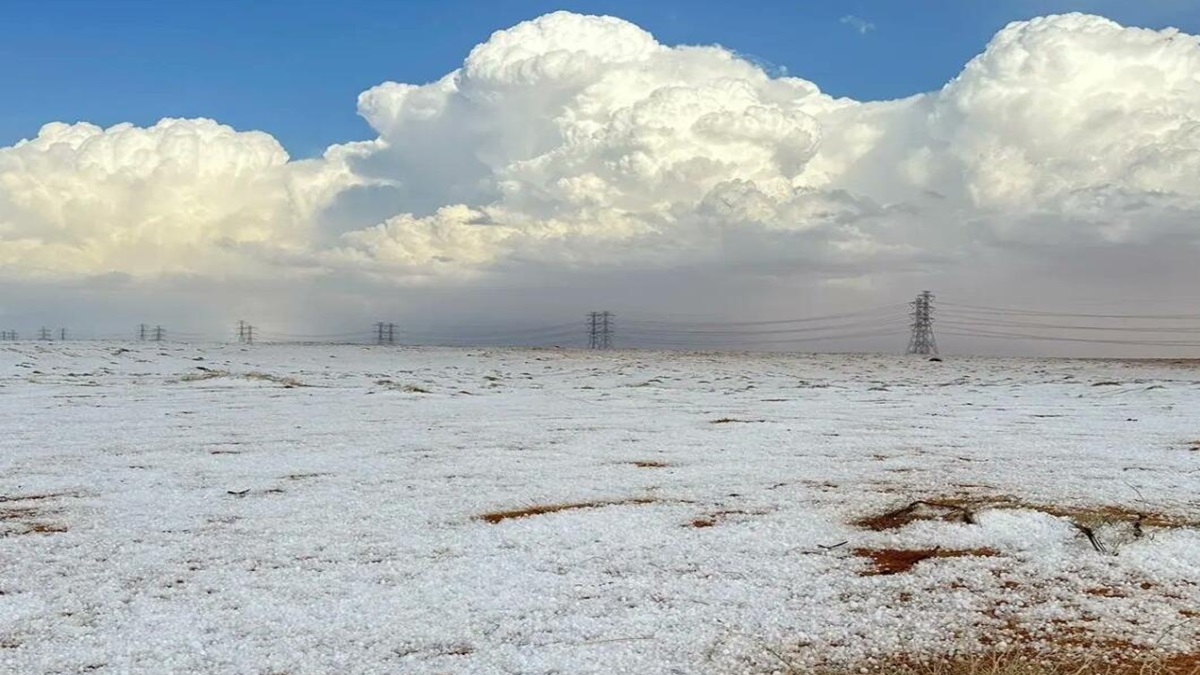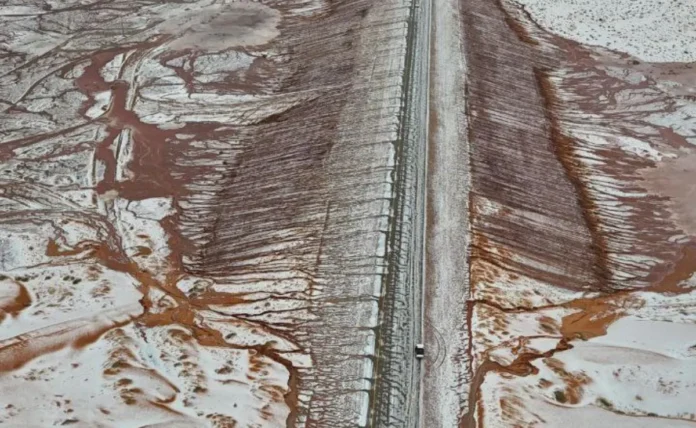Saudi Desert Sees Snowfall for the First Time Ever, Marking an Unprecedented Weather Event
The deserts of Saudi Arabia, renowned for their scorching heat and arid landscapes, witnessed an extraordinary event recently: snowfall. The Al-Jawf region, situated in the northern part of the country, saw a blanket of snow cover its sands, an event that has left residents and meteorologists alike astonished. This historic occurrence was accompanied by hailstorms and intense rainfall, adding to the surreal atmosphere in a region typically accustomed to high temperatures and dry weather year-round.
Images and videos of this unexpected snowfall have been widely circulated on social media, with many locals capturing the rare sight of snow-covered deserts. The photos show a striking contrast as the pristine white snow coats the familiar reddish sands of the desert, creating a scene that seems almost otherworldly. People from across Saudi Arabia and beyond are reacting with amazement, with many expressing disbelief at what they see as a once-in-a-lifetime event.

Weather Patterns Behind the Snowfall
According to meteorologists, this unusual weather event was primarily caused by an intense low-pressure system originating from the Arabian Sea. The low-pressure front brought heavy rainfall, hailstorms, and finally, snow to the northern parts of Saudi Arabia. These conditions are highly uncommon for a region that typically experiences extreme heat, particularly in the vast stretches of desert where temperatures can soar to above 50°C (122°F) during summer months.
Reports indicate that this low-pressure system was responsible for pulling cold air from higher altitudes down to ground level, where it collided with moist air, resulting in snowfall. This combination of factors created the perfect conditions for snow, even in an area so historically resistant to such phenomena.
An Impact of Climate Change?
As Saudi Arabia experiences its first recorded snowfall in the Al-Jawf desert, questions about climate change and its influence on weather patterns are once again in the spotlight. Experts in meteorology and environmental science have long warned that the impact of global warming may lead to more erratic weather events worldwide. While it is too early to definitively link this snowfall to climate change, the occurrence highlights how unpredictable the weather is becoming in regions around the world.
The global rise in temperatures, melting polar ice, and shifting weather systems are all contributing factors that could explain this unprecedented snowfall. The incident could be an indicator of changing climate patterns, which may bring more unusual weather to regions that traditionally experience stable, predictable climates.

Public Reaction and Significance of the Event
The people of Saudi Arabia, especially those in the Al-Jawf region, were quick to document and share this historical moment on social media. Posts on platforms like Twitter and Instagram showed people walking through the snowy landscape, visibly thrilled by the experience of snow in their desert homeland. Some residents have even made light of the event, humorously remarking that “winter has come to the desert,” while others view it as a divine sign or a blessing from nature.
The snowfall has also sparked curiosity and excitement among international audiences. People from around the world have expressed their fascination with the images and videos of snow in the desert, marveling at nature’s unexpected wonders. This rare snowfall is an event that has brought joy, intrigue, and a sense of wonder, especially to those who live in the region and may never have imagined snow in their lifetime.
What This Means for Saudi Arabia’s Climate Adaptation Plans?
Saudi Arabia, a country that has long been focused on its oil-driven economy, has increasingly acknowledged the importance of addressing climate change. The government has introduced various initiatives aimed at promoting environmental sustainability, including the ambitious “Saudi Green Initiative.” The aim is to plant billions of trees and reduce carbon emissions significantly. The unexpected snowfall serves as a timely reminder of the necessity to understand and mitigate climate-related challenges.
As weather patterns continue to shift globally, countries in traditionally arid regions may need to prepare for a future where extreme weather events become more common. Saudi Arabia, with its significant investment in futuristic cities like NEOM and a commitment to renewable energy projects, may find itself increasingly focused on climate adaptation as well as mitigation. Preparing for these kinds of rare but impactful weather events could become a crucial part of the country’s future environmental strategy.

A Moment in Meteorological History
The snowfall in Al-Jawf is likely to be remembered as one of the most memorable weather phenomena in Saudi Arabia’s recent history. For a country that has seen vast deserts and high temperatures define its climate, this snow event marks a unique moment and perhaps even a turning point in how its climate may be perceived. Scientists and meteorologists will undoubtedly continue to study this event to gain further insight into the evolving weather patterns affecting the Middle East.
As for the people who witnessed it, the snowfall serves as a beautiful and rare memory—a snapshot of a desert transformed into a winter wonderland.

